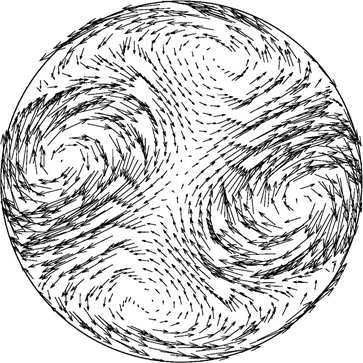Direct Numerical Simulations of Developed Turbulence
JAXA Supercomputer System Annual Report April 2016-March 2017
Report Number: R16E0042
- Responsible Representative: Susumu Goto(Osaka University)
- Contact Information: Susumu Goto(goto@me.es.osaka-u.ac.jp)
- Members: Keita Hanajima, Tetsuya Kawabe, Susumu Goto, Ken Komoda, Jun Kanki
- Subject Category: Basic Research(Numerical analysis,CFD)
Abstract
Turbulence is ubiquitous. Interestingly, small-scale eddies in turbulence have universal properties, which are independent of the kind of turbulence. We aim at reviewing the physics of this universality and constructing new turbulence models which can be applied to many problems in aerospace engineering.
Goal
Fully developed turbulence is ubiquitous in the field of aerospace engineering. We aim at revealing the physics behind the universal small-scale statistics, which are independent of boundary conditions, of high-Reynolds-number turbulence. The goal of the present project is to develop new turbulence models on the basis of the obtained knowledge of fully developed turbulence.
Objective
By conducting direct numerical simulations of fully developed turbulence under various boundary conditions, (i) we are revealing universal statistics and dynamics of turbulent flows, and (ii) we are verifying the statistical laws of turbulence which have been employed in turbulence models.
References and Links
N/A
Use of the Supercomputer
The present project is on the basis of direct numerical simulations of turbulent flows under various boundary conditions and careful investigations of the statistics and dynamics of simulated turbulence. We use the supercomputers for the numerical simulations and post-processing of obtained data.
Necessity of the Supercomputer
Since fully developed turbulence is composed of eddies at various length scales, in the numerical simulations of turbulence, we have to resolve the smallest-scale eddies and integrate for a sufficiently long time so that we can capture the slow motion of the largest-scale eddies. High-performance supercomputers are therefore necessary for the present project.
Achievements of the Year
To understand the origin of the small-scale universality of turbulent flows, we have developed new numerical codes for direct numerical simulations of turbulence under different boundary conditions. More concretely, in addition to the flows in a periodic cube and in a spherical container, we can now simulate channel flow, boundary layer flow, and flow in an arbitrarily shaped container.
We have also conducted direct numerical simulations of high-Reynolds number decaying turbulence under periodic boundary conditions to show that the turbulence decay is composed of two regimes with essentially different energy cascade processes.
Furthermore, we have conducted both of the direct numerical simulations and laboratory experiments of turbulence sustained in a precessing sphere to investigate its sustaining mechanism. Interestingly, small-scale turbulent eddies in the turbulence are sustained by energy cascade originating from the large-scale eddies (Fig. 1) created in the sphere.

Fig.1:Large-scale vortices in turbulence sustained in a precessing sphere. Two pairs of anti-parallel vortices effectively create small-scale turbulent eddies.
Publications
Peer-reviewed articles
1) Susumu Goto, J. C. Vassilicos, Unsteady turbulence cascades, Phys. Rev. E 94 (2016) 053108.
Presentations
1) Susumu Goto, Yasufumi Horimoto, The sustaining mechanism of turbulence in a precessing sphere. (29 June,2016,International Workshop on Theoretical Aspects of Near-Wall Turbulence Studies)
Computational Information
- Parallelization Methods: Hybrid Parallelization
- Process Parallelization Methods: MPI
- Thread Parallelization Methods: OpenMP,Automatic Parallelization
- Number of Processes: 64
- Number of Threads per Process: 4
- Number of Nodes Used: 8
- Elapsed Time per Case (Hours): 10
- Number of Cases: 10
Resources Used
Total Amount of Virtual Cost(Yen): 2,015,342
Breakdown List by Resources
| System Name | Amount of Core Time(core x hours) | Virtual Cost(Yen) |
|---|---|---|
| SORA-MA | 1,166,455.45 | 1,917,836 |
| SORA-PP | 0.00 | 0 |
| SORA-LM | 0.00 | 0 |
| SORA-TPP | 0.00 | 0 |
| File System Name | Storage assigned(GiB) | Virtual Cost(Yen) |
|---|---|---|
| /home | 94.24 | 888 |
| /data | 476.84 | 4,498 |
| /ltmp | 9,765.63 | 92,119 |
| Archiving System Name | Storage used(TiB) | Virtual Cost(Yen) |
|---|---|---|
| J-SPACE | 0.00 | 0 |
Note: Virtual Cost=amount of cost, using the unit price list of JAXA Facility Utilization program(2016)
JAXA Supercomputer System Annual Report April 2016-March 2017


